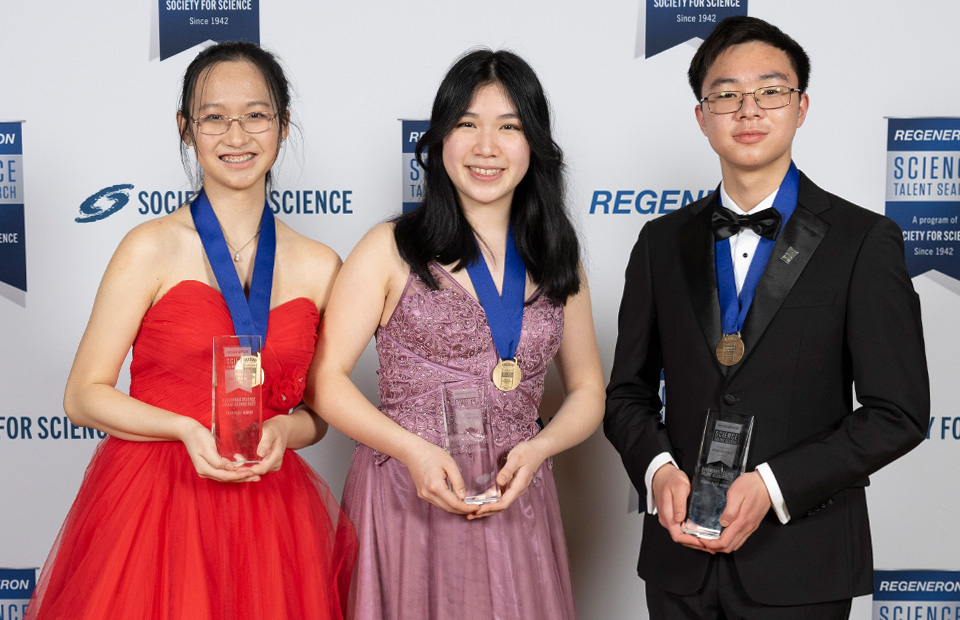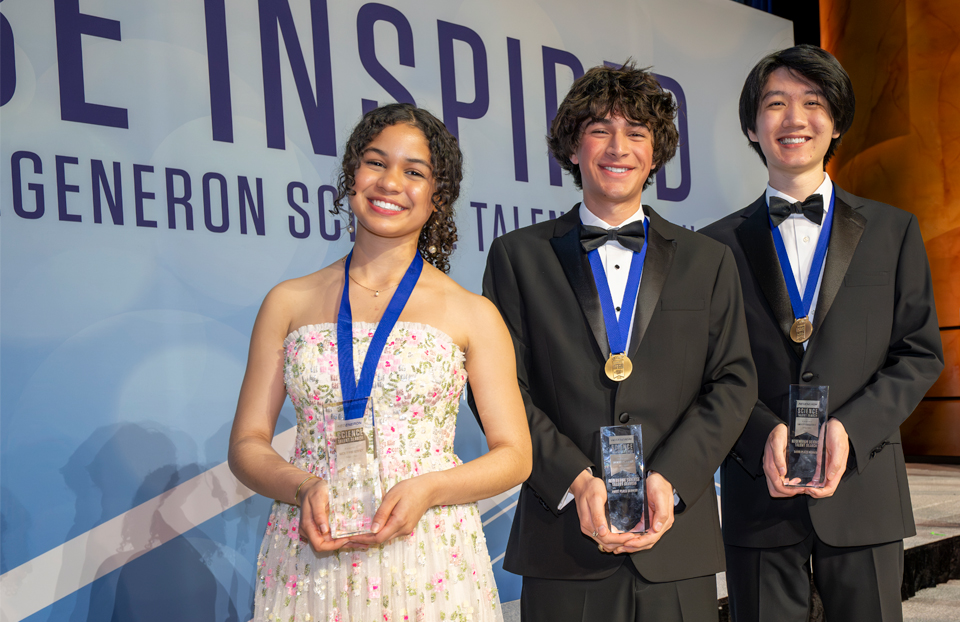Regeneron STS, Young & Amazing
Students win $1.8 million at Regeneron Science Talent Search 2022

Regeneron Pharmaceuticals, Inc. and Society for Science (the Society) announced the top ten winners headed by Christine Ye, 17, of Sammamish, Wash., who won the top award in the 2022 Regeneron Science Talent Search, the nation’s oldest and most prestigious science and math competition for high school seniors.
For the first time since 2019, the competition was held in person under strict COVID-19 protocols in Washington, D.C., after virtual competitions in 2020 and 2021. Forty finalists, including Christine, were honored during a livestreamed award ceremony emceed by Saturday Night Live’s Melissa Villaseñor. More than $1.8 million was awarded to the finalists, who were evaluated based on their projects’ scientific rigor, their exceptional problem-solving abilities and their potential to become scientific leaders.
Christine Ye won first place and $250,000 for her project, which analyzed the gravitational waves emitted from huge collisions between neutron stars (collapsed super-dense stars) and black holes. By analyzing data gathered at the Laser Interferometer Gravitational-wave Observatory (LIGO), where scientists use data from these waves to measure astronomical objects, she set a novel precedent for modeling rapidly-rotating neutron stars; showing that a quickly spinning neutron star could be extra massive, but still smaller than a black hole.
Second place and $175,000 went to Victor Cai, 18, of Orefield, Pa., who created a short-range, narrow-bandwidth radar that calculates distance by transmitting two signals at different frequencies and then measuring the phase difference between them. By combining a multiple frequency continuous wave radar algorithm with software that replaces specialized hardware and then writing additional algorithms to correct inaccurate readings, he created a radar accurate to within 12 cm. Victor’s research could help pave the way for more self-driving vehicles on the road with less concern over bandwidth.
Third place and $150,000 went to Amber Luo, 18, of Stony Brook, N.Y., for developing a software, RiboBayes, that identifies key regions known as “ribosome pause sites” along a cell’s mRNA transcripts that regulate protein synthesis. Her tool reveals critical insights into how ribosome pause site expression is altered by diseases. By providing greater ability to locate and evaluate the key components of protein synthesis that occur at these ribosome pause sites, RiboBayes enables researchers to gain a more complete view of the mechanisms underlying a wide range of diseases, such as Alzheimer’s disease and cancers.
“The Regeneron Science Talent Search winners give me hope for the future, and I congratulate them on their tremendous success,” said Maya Ajmera, President and CEO of Society for Science, Publisher of Science News and 1985 Science Talent Search alumna. “For the first time in two years, we have been able to gather in person to celebrate the next generation of scientific leaders who are motivated by curiosity and inspired to solve the world’s most intractable problems. I am impressed by their scientific research and strength of character.”
The Regeneron Science Talent Search provides a national stage for future leaders in STEM – bringing together the best and brightest young minds to present their original research ideas to world-class scientists. The competition celebrates the hard work, innovative thinking, and creativity of students who are bringing a fresh perspective to solving significant global challenges through rigorous research and cutting-edge discoveries. The judging panel also considers how these research efforts, innovative thinking and leadership qualities demonstrate the students’ ability to drive forward critical STEM fields in the future.
“Congratulations to the winners of the Regeneron Science Talent Search 2022, and to all our impressive finalists. Each of the students are brilliant scientists and mathematicians, and each has the power to bring real, positive change to society and help address future existential challenges, whether it be climate change, genetic-based diseases or understanding the universe,” said George D. Yancopoulos, M.D., Ph.D., Co-Founder, President and Chief Scientific Officer of Regeneron, and a winner of the 1976 Science Talent Search. “Having been a winner of the STS back in 1976, I can say from first-hand experience that this is only the beginning of a great path forward for our winners, finalists and scholars. Never stop being curious, never stop exploring and never stop looking for answers.”
Other top honors from the competition include:
Fourth Place: Daniel Larsen, 18, of Bloomington, Ind. received a $100,000 award for answering an important math question about the abundance of Carmichael numbers, which resemble prime numbers even though they are not true primes. He showed that for any sufficiently large number, there is always a Carmichael number hidden between it and its double. Daniel hopes his work will lead to a better understanding of these intriguing pseudoprimes. Prime numbers are crucial for cryptography, which uses large primes to help keep communications secure.
Fifth Place: Neil Chowdhury, 18, of Bellevue, Wash. received a $90,000 award for creating a computer model to study the role of a histone protein implicated in colon cancer and found that the histone caused changes to two key processes regulating the way DNA folds itself to fit into the nucleus of cells. His simulations of polymers, using data from a colon cancer cell line, accurately reproduced recent experimental results and showed that the histone modification caused changes in the DNA’s physical formation, specifically compartmentalization and loop extrusion.
Sixth Place: Aseel Rawashdeh, 17, Austin, Texas received a $80,000 award for developing an inexpensive way to kill the larvae of mosquitos that spread viral illnesses. By incorporating an essential oil (such as cinnamon, garlic or orange) into baker’s yeast microcapsules, she made a cost-effective bait that kills the larvae of mosquitos that spread malaria. Equally important, in early tests, her larvicide’s encapsulated oils appear to be harmless to nearby algae and non-targeted insect larvae.
Seventh Place: Pravalika Gayatri Putalapattu, 17, of Centreville, Va. received a $70,000 award for designing a video-assisted workflow recognition program to monitor laparoscopic gall bladder surgeries in real time, verify the surgeons’ actions, and flag errors so immediate corrective action can be taken. Her work was inspired after a close cousin died from a preventable surgical mistake by a “tired, overworked, underpaid surgeon in India.” Her new system is five times faster than similar systems used currently.
Eighth Place: Neil Rathi, 17, of Palo Alto, Calif. received a $60,000 award for identifying common linguistic patterns in four languages that support the theory that human language evolved for greater efficiency in communication. Using a machine learning model, Neil studied how our minds optimize language by fusing multiple informational elements into the smallest meaningful unit of a word such as “ed” in “talked,” which conveys both past tense and word completion, and he found patterns of “informational fusion” in all four languages.
Ninth Place: Amara Orth, 18, of Glenwood, Iowa received a $50,000 award for eavesdropping on her family’s honeybees so she could identify the changes in vibroacoustic patterns in each hive. She measured the sounds and vibrations from bees in 25 hives and developed an AI model to analyze the colony’s health with an accuracy of 92%. If the data is gathered and decoded in time, her system may give beekeepers time to prevent colony collapse.
Tenth Place: Luke Robitaille, 18, of Euless, Texas received a $40,000 award for using the mathematical concept of topological entropy to study simple braids, a formal way to describe the complicated patterns that arise from intertwining multiple lengths of string. Luke proved that most simple braids are orderly for low numbers of strands, but as the number of strands grows large, nearly all simple braids are chaotic. His work could help researchers better understand the chaotic mixing of fluids.
Hailee Han Byur Youn, 17, of Roslyn, N.Y. was named the Seaborg Award winner and given the opportunity to speak on behalf of the Regeneron Science Talent Search Class of 2022. The 40 finalists chose Hailee as the student who most exemplifies their class and the extraordinary attributes of nuclear chemist Glenn T. Seaborg, who won the Nobel Prize for Chemistry in 1951 and served on the Society’s Board of Trustees for 30 years.
All other finalists received $25,000, and each finalist will join the ranks of other Science Talent Search alumni, many of whom have gone on to have world-changing careers in STEM fields, and some of whom have earned the most esteemed honors in science and math, including the Nobel Prize, National Medal of Science and MacArthur Foundation Fellowships. In total, Regeneron awarded $3.1 million in prizes through the Regeneron Science Talent Search 2022, including $2,000 to each of the top scholars and their schools.


